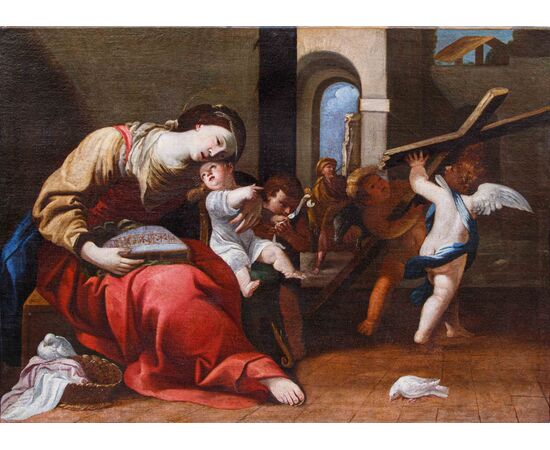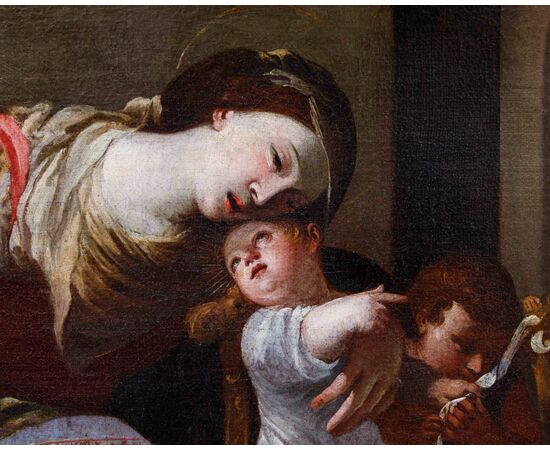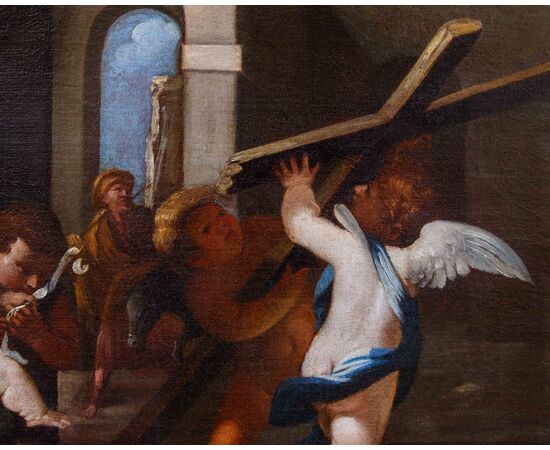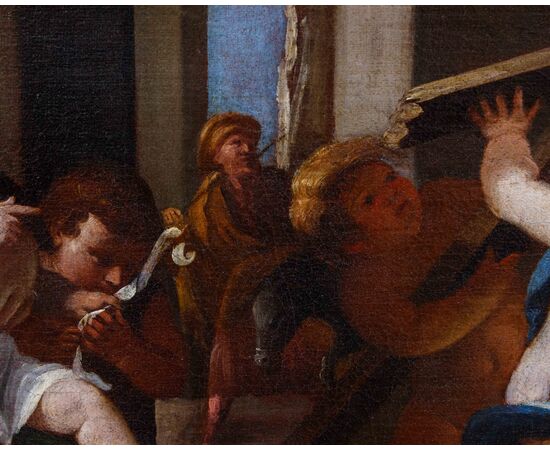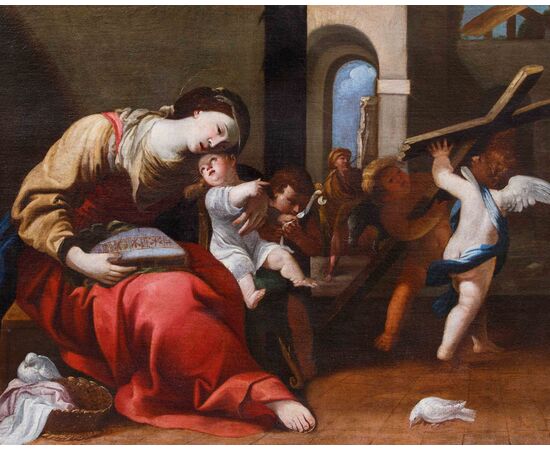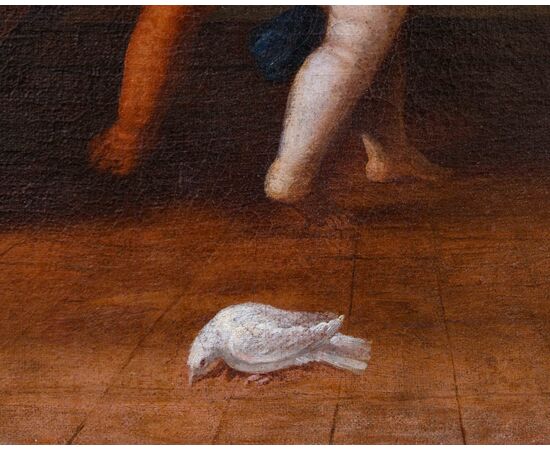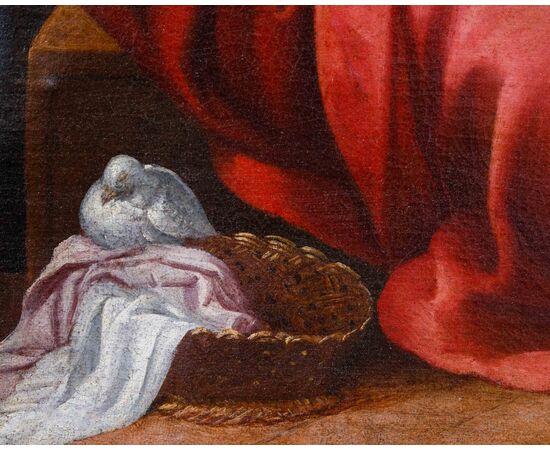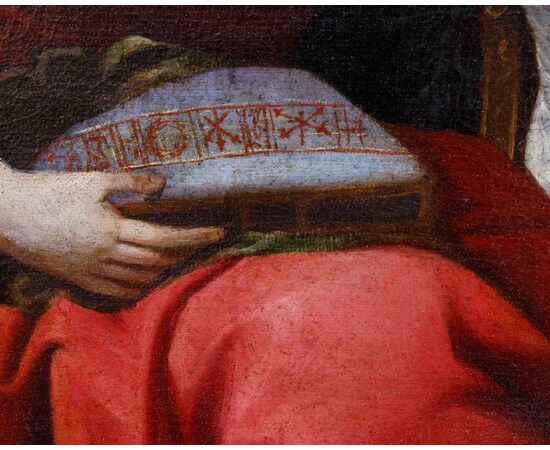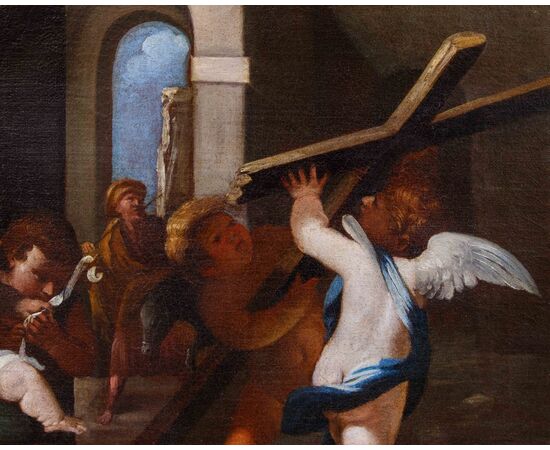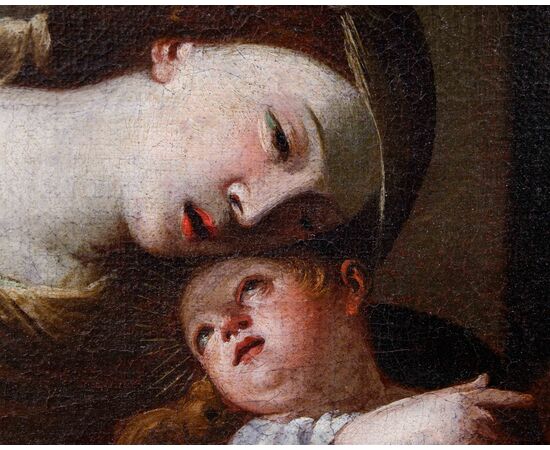Workshop of Raffaello Vanni (Siena, 1595-1673), Madonna and Child, Young Saint John and two angels announcing the crucifixion
Workshop of Raffaello Vanni (Siena, 1595-1673)
Madonna and Child, Young Saint John and two angels announcing the crucifixion
Oil on canvas, 69 x 94 cm
With frame, 85 x 100 cm
The painting discussed here is one of the many variations of a successful composition conceived by the well-known Sienese artist Raffaello Vanni. The prototype of the subject, which evidently had considerable success, coincident with a work passed into a private collection, allows us to establish when the painter conceived this composition. The canvas, in fact, is linked to Vanni's works from the early 1640s: in particular, it shows clear analogies with the Saint Helena in Santa Maria in Publicolis in Rome, executed in 1644 for Cardinal Marcello Santacroce. Here the saint has a typology so similar to that of the Madonna in the painting under examination that it leads us to think that the painter used the same model. The use of color that models the soft drapery also appears identical, so the red robe of Saint Helena marked by pasty folds reappears in the Madonna of the work presented here. Not to mention the same nuanced delicacy of the milky complexions that unites the two works with the Madonna and Child and seven seraphim of the Banca Monte dei Paschi di Siena (inv. 2961), another cornerstone of this extraordinary 1644, the year that sees the definitive consecration of the painter not only in Siena but also in Rome, where he actively participates in the great enterprise of the fresco decoration of Palazzo Patrizi. The scene takes place in a domestic setting: the Virgin is embroidering, when the Child draws her attention to two angels who are raising the Cross. The Madonna abandons her work and with a melancholy expression tenderly embraces the Child while Saint John tries to console him. Saint Joseph, vigilant in the background, arrives with the donkey probably to flee with the Family to Egypt. The episode, which constitutes a clear premonition of the Passion, stands out for its pathetic and dramatic accents. The composition is throbbing both for the dynamism of the groups and for the overheated poetics of the affections, key components with regard to the development of Baroque taste. This compositional scheme introduced by Vanni, also thanks to the circulation of engravings, spread throughout the peninsula and was imitated by various artists: crucial in this sense is the version of the painting located at the Neapolitan church of Santa Maria di Chiaia.
Raffaello Vanni was a painter who worked mainly in his native city, Siena, straddling late Mannerism and the first manifestations of the Baroque, leaving a significant mark on Sienese art of the 17th century. Born in 1595, his artistic training is rooted in an environment still deeply influenced by the great Tuscan Mannerist tradition, but Vanni soon proved sensitive to the new currents that were emerging in Rome and elsewhere. His first steps in the art world probably saw him as a pupil or in any case close to the workshop of Francesco Vanni, his father and esteemed Mannerist painter. From him he learned the rudiments of drawing, composition and the use of color, absorbing that grace and elegance typical of Sienese Mannerism. However, Raffaello did not limit himself to replicating his father's style; his desire for updating led him to a fundamental trip to Rome. In the papal capital, Vanni was able to come into contact with the works of the great masters of the early Baroque, in particular with those of Pietro da Cortona, whose dynamism, chromatic richness and monumentality of the figures deeply fascinated him. This Roman experience was crucial for his stylistic evolution. Upon his return to Siena, he brought with him a renewed sensibility, combining the Mannerist refinement inherited from his father with a greater vitality and drama, typical of the nascent Baroque taste. His works, scattered in various churches and palaces of Siena and its surroundings, bear witness to this stylistic synthesis. Raffaello Vanni was a prolific artist, capable of addressing sacred and profane themes with equal skill. His altarpieces are distinguished by their balanced composition, the skillful use of light and the expressive rendering of the characters, often characterized by moving drapery and eloquent gestures. Despite the Roman influence, Vanni always maintained a link with the Sienese tradition, visible in the delicacy of the faces and in a certain compositional grace that was never completely abandoned in favor of pure Baroque impetus. His career lasted for many decades, going through different stylistic phases that reflect the cultural and artistic changes of the seventeenth century. He died in his Siena in 1673, leaving an artistic legacy that contributed to defining the Sienese pictorial landscape of his time, standing as a transitional figure between two eras and demonstrating the ability to assimilate and reinterpret new trends without ever losing his identity.

